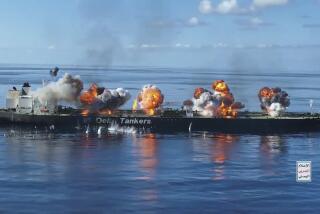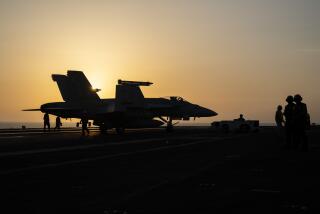Burning Vessel Sends Smoke Signal to Hussein : Persian Gulf: U.S., Kuwaiti sailors blow up old Iraqi ship. Message implied: Comply or else.
- Share via
KUWAIT CITY — A joint search team of armed U.S. and Kuwaiti sailors blew up an old Iraqi navy vessel 20 miles off the coast of Kuwait on Saturday, sending thick black plumes of smoke toward Kuwait city and a clear message to Iraqi President Saddam Hussein.
True, no one was aboard the Iraqi ship, a rusted 40-foot relic left behind when Baghdad’s occupation forces were forced to flee Kuwait last year. And it took nearly an hour, hundreds of rounds of machine-gun fire, dozens of rockets and, finally, a healthy dose of diesel fuel before the pathetic little target sank in the latest of the U.S. joint military exercises with Kuwait in and around the Persian Gulf.
But, in the seesaw psychological war now emerging between Iraq’s defiant leader and the U.S.-led military machine seeking to force Baghdad’s compliance with a wide array of U.N. resolutions, Saturday’s live-fire target practice was something of a heralded victory.
The dramatic “search-and-destroy mission” was filmed by three major American television networks and, perhaps most important, by a film crew from Kuwait’s Ministry of Defense and Moral Guidance--footage later showcased on Kuwaiti Television, a favorite among many viewers in the strategic, nearby Iraqi metropolis of Basra.
The message was unmistakable: Comply or accept the consequences.
Or, as Kuwait’s naval training officer, Col. Khalid Shatei, couched the assault on the Iraqi target before the morning-long exercise, “I wish it was real.”
For their part, the U.S. Navy officers involved tried to play down the importance of Saturday’s target practice. Lt. Cmdr. Michael Wood stressed that the board-and-search exercise was a major training event, which he said would be a success whether or not they managed to sink the unarmed, unmanned boat.
But the exercise also provided a dramatic view of how the on-again, off-again standoff between Washington and Baghdad over mandatory U.N. weapons inspections and a host of other requirements of cease-fire resolutions Iraq accepted to end the war last year is increasingly becoming a battle fought not with bullets or even words, but with images.
The timing of Saturday’s display of U.S. military might in the Persian Gulf could not have been better for a 22-member U.N. weapons inspection team that spent most of the first day of a weeklong mission inside their Baghdad hotel rooms. Saturday, the team was told, was a national holiday in Iraq, the anniversary of the end of Hussein’s brutal eight-year war with Iran.
What is more, the Iraqi president used the occasion to mount a blistering, verbal assault on the United States in a national address, deepening a tone of Iraqi defiance that greeted the team even before its arrival with an announcement that the inspectors would not be permitted inside any government ministry buildings during this inspection trip.
Saturday’s show of force, combined with a U.S. military presence in Kuwait and the Gulf that grows larger every day, may make the U.N. arms inspectors’ negotiating position a bit easier and the likelihood of a U.S.-led military strike against the Iraqi regime a bit greater.
The assault on the Iraqi vessel--one of dozens that Iraq used along Kuwait’s coastline to enforce its seven-month occupation of the tiny emirate before abandoning them in flight--is just one element of a military display that the U.S. Navy and Marines have planned for audiences from Los Angeles to Basra, images meant to both discourage the Iraqi regime and encourage its enemies.
Today, the Navy is flying the Western media to the aircraft carrier Independence, centerpiece of the Persian Gulf battle group that would be the staging ground for any future air strike on Hussein’s military targets in southern Iraq, among them air bases and aircraft that have been bombing positions held by Iraq’s opposition Shiite rebels.
In the coming days, there will be U.S.-Kuwaiti air strikes by assault helicopters on mock military bases just a few miles from Iraqi territory, more naval maneuvers and staged ground assaults. And later, there will be other show-of-force exercises to accompany the arrival of Army Special Forces units and infantry troops from Ft. Hood, Tex., and Ft. Campbell, Ky.
Baghdad, of course, has battled back in the image war.
Hussein and his information ministry have used their limited assets to yield maximum results. The most vivid image: a bare-chested Hussein swimming against a stiff current in the Tigris River, surrounded by a gaggle of bodyguards, on the day last month that he forced an eleventh-hour compromise with U.N. officials that allowed arms inspectors into Baghdad’s Agriculture Ministry.
But a propaganda war that uses the largely independent Western media as its conduit is not without risks.
That footage of Hussein’s river swim, for example, which was aired on Baghdad Television and released almost immediately to all major Western TV networks, provided veteran analysts of the Iraqi regime documentary proof of a long-held theory that Hussein employs “look-alikes” as decoys to protect himself.
“If you watched that footage closely, you could see two Saddam clones swimming beside him,” said one diplomatic expert on the Iraqi leader.
Even Saturday’s stage-managed naval assault, meant to show the muscle of Kuwait’s small but rebuilding military, was not without flaws.
It took the joint attack force nearly an hour to set the Iraqi boat ablaze, and that was accomplished only by firing a rocket at short range into a fuel supply that had been placed aboard before the exercise began. And, in the long gun battle with the unarmed, unmanned, unanchored vessel, there was even a casualty--a Kuwaiti sailor who burned his leg on a shell casing and had to be carried to safety.
More to Read
Sign up for Essential California
The most important California stories and recommendations in your inbox every morning.
You may occasionally receive promotional content from the Los Angeles Times.













